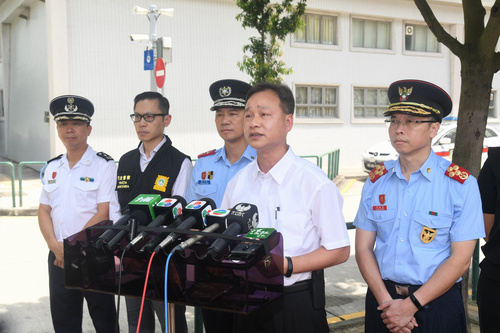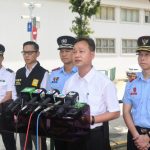 The Commissioner-General of the Unitary Police Service, Mr Ma Io Kun, speaks during a media session to showcase the Government's communication and broadcasting equipment used in public emergencies.
The Commissioner-General of the Unitary Police Service, Mr Ma Io Kun, speaks during a media session to showcase the Government's communication and broadcasting equipment used in public emergencies.
Two new emergency warning systems will come into operation later this month. The systems are designed to strengthen the city’s public emergency alert system, in order to share important safety information during emergencies.
The Commissioner-General of the Unitary Police Service, Mr Ma Io Kun, who also oversees the city’s emergency response mechanism, provided the information today during a tour for representatives of the media to introduce the new emergency warning systems.
Officials from, respectively, the Unitary Police Service, the Public Security Forces Affairs Bureau, and the Judiciary Police, provided information during the tour about the “high ground emergency warning system” and the new “broadcasting and warning system for low-lying areas”.
The two systems were designed to broadcast important safety information to the public whenever authorities issue a level three (orange) storm surge warning or above, as well as in the eventuality of other public emergencies, Mr Ma said.
The “high ground emergency warning system” comprises a set of powerful speakers – each with a two-kilometre range – deployed in three hills across the city, namely the Guia Hill, Big Taipa Hill and Alto de Coloane.
The “broadcasting and warning system for low-lying areas” includes emergency speakers set up in 90 surveillance camera poles across Macao, Taipa and Coloane.
In addition, an integrated command system for the management of public emergencies – developed by Tsinghua University – is to undergo a trial run by year-end, once each of the five sub-systems are optimised.
After Typhoon Hato, in August last year, the Government has been making unremitting efforts to optimise methods used to deliver emergency information to the public in a timely manner, in order to allow members of the public to prepare in advance in case of a disaster.
Alert messages and warnings of adverse weather can be broadcast not only via traditional media (such as radio and television), but also disseminated via social media platforms (such as WeChat and Facebook), as well as via monitors set up in all immigration checkpoints and in 34 locations on the city’s streets.
Following Typhoon Hato, the Government has purchased additional 60 walkie-talkie radios for the use of civil organisations. The city’s 29-member civil protection unit will have dedicated walkie-talkies for internal communication and coordination of the city’s civil protection mechanism.
Police patrol vehicles are to be equipped with speakers in order to spread public safety messages – in Chinese, Portuguese, and English language – in cases of emergencies. In the event of major disasters or emergencies, mobile users will receive text messages with up-to-date emergency information.
Meanwhile, the number of dedicated phone lines for hotline services during emergencies will be increased to 55, from the current 22.
The civil protection system did not solely rely on the Government; community participation was equally important, in order to advance Macao’s overall abilities to prevent and to respond to public emergencies, Mr Ma said.
Public security and safety forces held last week a media briefing to introduce to the public the newly acquired emergency rescue equipment.


